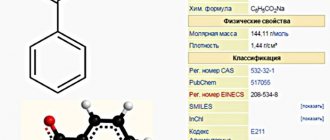Sodium acetate is a type of acetic acid salt. This compound is most widely used in the food industry as an acidity regulator, flavor and odor enhancer, and a substance that extends the shelf life of a preservative. It is known under the number E262. Sodium acetate is used in textile production. The additive is used to neutralize sulfuric acid in waste liquids and as a photoresist for aniline dyes. Sodium acetate is also used in the tanning industry in combination with chromium salts and in the production of rubber. In its dehydrogenated form, sodium acetate is medium-sized crystals whose color ranges from pale yellow to bright ocher.
What is sodium acetate?
Sodium acetate (E262) is a homogeneous powder of solid granules of a yellowish or brownish tint. It is especially widely used in food production - it is introduced to extend shelf life. Only an uncolored substance is used as a preservative, without foreign additives.
Experts say that this type of acetic acid salt is completely safe for the human body and the environment. Sodium acetate is an inexpensive supplement that you can make yourself. So, housewives can reproduce sodium acetate right in their kitchen by mixing soda and vinegar. If the resulting mixture is evaporated, a homogeneous powder will be obtained, an analogue of E262. Sodium acetate is also common naturally: it can be found in plant and animal cells and is often found in a variety of fruits.
The powder is characterized by a weak, barely perceptible salty taste and the same unexpressed vinegary smell. Today, large industrial enterprises are engaged in the production of the substance. In food production it is used as an acidity stabilizer and flavoring agent. The substance is used as a preservative in the production of canned vegetables and fruits to soften the taste of acetic acid. In addition, this type of acetic acid salt is added to baking flour in order to protect finished baked goods from “potato disease”. The additive is found in chips - there it is responsible for enhancing the aroma. Sodium acetate increases the shelf life of sauces, jams, soups and fish products.
In addition to the food industry, sodium acetate is found in the textile, rubber and paint industries, in the production of adhesives and polymers. The additive is often added to animal feed: thanks to it, poultry can noticeably gain weight. Sodium acetate increases egg production.
Main manufacturers
Sodium acetates are supplied to the domestic market by: the Ural Industrial Chemicals Plant (Magnitogorsk), the plant named after.
Y. M. Sverdlova and Organika LLC (both city of Dzerzhinsk, Nizhny Novgorod region). A large volume of products is produced by the Chinese company Fooding, which includes 35 chemical enterprises from several regions of the country.
The products of the German company W. Urlich GmbH, which has a 70-year history of development, are distinguished by their high quality.
The statement that when ingested by the body, the food additive E 262 turns into carcinogenic nitrites does not stand up to criticism.
Sodium acetates are found inside the cells of plants and living organisms. They are natural preservatives for all fermented milk products as a direct result of bacterial fermentation. If you don’t use spoons of soda or drink liters of vinegar, the food additive E 262 will be a useful and safe component of products.
Formula and properties of sodium acetate
The formula for sodium acetate is as follows:
C2H3O2Na
Sodium acetate is a crystalline powder with a subtle salty taste and vinegary odor. It dissolves well in water. So, to dissolve 76 grams of a substance, 100 milliliters of liquid will be required. Sodium acetate is practically insoluble in alcohols. It is characterized by hygroscopicity. The substance is not classified as flammable. The additive has a low degree of toxicity and is virtually harmless to the environment.
Sodium Acetate Formula
To transport sodium acetate, it is recommended to use a special moisture-resistant layer. This is necessary so that the substance does not come into contact with the liquid and does not react with it.
The density of sodium acetate is 1.45 g/cm³.
Decomposition temperature – 324°C.
Properties of the chemical
It is not without reason that sodium acetate is called “hot ice” because it becomes very hot during the exothermic crystallization process. This substance has a crystalline structure. It is practically colorless and has a faint odor of acetic acid. Its crystals have a distinctive feature: they dissolve very poorly in ether and alcohol, but when interacting with water they very quickly turn into a solution of sodium acetate. So, 76 g of this substance dissolves in 100 ml of H2O. Sodium acetate has low toxicity and is non-flammable. Its specific heat of melting is 264-289 K, and its decomposition temperature is 324 °C. Sodium acetate, the trihydrate of which has a melting point of 58 °C, when heated to 100 °C in a container placed near boiling water, dissolves in its water of crystallization (melts). Thus, it is converted into a solution. When it cools, a supersaturation of this substance in water is observed. Such a solution is remarkably supercooled to a temperature of 20-24 °C without the formation of its solid phase. After pressing the metal in the container, a crystallization center is formed. During the growth process, it causes this solution to transform into the solid phase of sodium acetate trihydrate. This process is accompanied by a significant release of heat (264-289 kJ/kg).
Preparation of sodium acetate
It is possible to obtain sodium acetate in different ways. In laboratory conditions, the substance is formed by the interaction of acetic acid with sodium carbonate:
C2H3O2H + NaHCO3 ⟶ CH3CO2Na + H2O + CO2↑
This is the most common reaction that occurs when preparing dough. 84 grams of sodium bicarbonate are mixed with 750 grams of wine vinegar, resulting in 82 grams of sodium acetate. As a result of the above reaction, not only sodium acetate is formed, but also carbonic acid.
Sodium acetate can be obtained by dissolving sodium metal in acetic acid:
2CH3CO2H + 2Na ⟶ 2CH3CO2Na + H2↑
It can also be removed by reaction of an ester with alkyl halides:
CH3CO2Na + CH3CH2Br → CH3CO2C2H5 + NaBr
When exposed to elevated temperatures, sodium acetate decomposes into sodium carbonate and acetone:
2CH3CO2Na → Na2CO3 + (CH3)2CO
Sodium acetate is also obtained through dry distillation of wood.
Reactions[edit]
Sodium acetate can be used to form an ester with an alkyl halide such as bromoethane:
CH 3 COONa + BrCH 2 CH 3 → CH 3 COOCH 2 CH 3 + NaBr
Sodium acetate undergoes decarboxylation to form methane (CH 4 ) under forced conditions (pyrolysis in the presence of sodium hydroxide):
CH 3 COONa + NaOH → CH 4 + Na 2 CO 3
Calcium oxide is a typical catalyst used for this reaction. Cesium salts also catalyze this reaction. [ citation needed
]
Areas of application of sodium acetate
Sodium acetate is a substance that is considered absolutely harmless to both humans and the environment. This feature explains the prevalence of this type of acetic acid salt in a variety of areas. The substance is most widely used in the food industry.
The additive is valued for its ability to regulate acidity and the ability to act as an excellent preservative and stabilizer. The main task of the substance is to preserve the taste and aromatic qualities of the food product, shape and texture, and improve consistency.
Sodium acetate is most often added to flour to prevent the development of “potato disease” in finished baked goods. It prevents the development of spores that cause the disease.
Sodium acetate is added to canned vegetables and fruits to neutralize the vinegar taste and smell. The additive is used to produce chips, crackers and other snacks – it exaggerates their taste and aroma. E262 is found in various sauces, bouillon cubes and freeze-dried foods.
Sodium acetate is widely used not only in the post-Soviet space, but also in Europe and the United States. This popularity is due to its low toxicity and lack of harm to human health and the environment.
Sodium acetate is very popular in the following industries:
- chemistry - the additive is necessary for the production of large quantities of dyes; it regulates the course of the polycondensation reaction;
- biochemistry - sodium acetate allows you to control the acidity level of many reactions;
- medicine - the additive is widely used in the production of diuretics and disinfecting ointments; it is found in painkillers;
- production of skin care cosmetics - sodium acetate is found in almost all types of soap;
- textile and leather industries - the additive is used to give color to materials;
- production of rubber and caoutchouc – sodium acetate is necessary for the production of artificial rubber;
- agricultural farming - sodium acetate is used as an additive that extends the shelf life of produced grain crops and green feed; it allows you to quickly increase the weight of birds and livestock and increase the volume of masonry;
- construction - the additive increases the resistance of the concrete mixture to low temperatures; it is added to the mixture for the production of monolithic structures, concrete and reinforced concrete slabs;
- electroplating - sodium acetate serves as an electrolyte and buffer solution;
- photo business - a composition based on sodium acetate allows you to fix compositions for photos;
- environmental protection - sodium acetate is introduced into wastewater to purify it;
- household - sodium acetate is used to make medical heating pads and heaters; it is hot ice. During crystallization, it generates heat.
Sodium acetate in the food industry
In the international codification of additives, sodium acetate is listed under the index E262. It simultaneously acts as a preservative, odor enhancer and acidity regulator. Sodium acetate softens the vinegary smell and taste in pickled fruits and berries. In baking, it prevents the development of harmful bacteria and microorganisms that can have a negative impact on product quality. It is added to snacks to improve taste and enhance aroma. Sodium acetate is added to sauces, in particular to mayonnaise, bouillon cubes and freeze-dried soups.
The product's name
The chemical substance in the international codification of food additives is listed under the index E 262 (in other documents the spelling E-262 may appear).
GOST 54626–2011 established the definition of Sodium acetates (an international synonym for Sodium Acetates).
Food grade sodium acetates are presented in two chemical types:
- Sodium acetate:
- Sodium Acetatei;
- sodium acetate (chemical name);
- E 262i.
- Sodium diacetate:
- Sodium Acetateii;
- sodium hydroacetate;
- sodium acetate, acidic (chemical name);
- Sodium Hydrogen Acetate (Sodium Diacetate);
- E 262ii.
German names: Natriumacetat, Natrium salz der Essigsaure.
French: Acetate de Sodium, Sel de Sodium de l'aside acetique.
The effect of sodium acetate on the human body
The additive itself is not dangerous to the human body. But people with an allergy to vinegar should refrain from consuming products that contain it - carelessness in choosing food can lead to a worsening of the condition and even cause anaphylactic shock. So, if you have allergies, it is better not to eat flour products, chips, canned vegetables and canned fish.
E262 is widely used in the production of snacks, which are difficult to classify as healthy products. The additive enhances their taste and aroma, extends shelf life. It is not recommended to consume these types of products for those who have diseases of the gastrointestinal tract.
Experts claim that the supplement is completely safe and suitable for use in almost any volume. But you still shouldn’t abuse products with it.
The additive is officially approved in the United States, Canada, Ukraine, Russian Federation, Australia, and European countries. No official data on its connection with the appearance and development of malignant tumors, gene mutations, disorders of the reproductive system and poisoning have been identified. At least when it comes to food products. But several cases of allergic reactions in people have been recorded.
Experts advise people who have problems with the functioning of the autonomic system, gallbladder, gastrointestinal tract, liver, kidneys and cardiovascular system to refrain from consuming sodium acetate.
Exceeding the daily norm can result in a long list of not the most pleasant symptoms: migraines, lack of coordination, discomfort in the stomach, cramps, difficulty breathing, changes in the color of the skin and mucous membrane.
Package
According to GOST 54626–2011, the following can be used for packaging food sodium acetates:
- grocery woven bags made of polypropylene (most often used);
- boxes for confectionery products made of corrugated cardboard;
- multilayer paper bags.
A mandatory requirement is the presence of an additional liner made of durable polyethylene intended for food packaging.
It is allowed to pack food preservatives in other safe containers (barrels, canisters, containers).
In addition to the standard labeling, there must be a “Keep away from moisture” sign.
Harm of sodium acetate
Some evidence suggests that sodium acetate may cause minimal harm to human health if too much sodium acetate is consumed. Thus, sodium acetate has carcinogenic properties: in the intestine it is converted into nitrate, which can cause the formation of malignant tumors or allergies. But such a reaction of the body occurs extremely rarely.
Experts also advise limiting the consumption of foods that contain sodium acetate in children. With prolonged inhalation of vapors or consumption of excessive amounts of sodium acetate, the following may occur: conjunctivitis, skin rashes and redness, mild allergic reactions, irritation of the upper respiratory tract and difficulty breathing, metabolic disorders.
Information sources:
Alf. index: 1-9 AZ
More on the topic:
- SODIUM ACETATE - chemical encyclopedia
- Sodium acetate - medications
List of products containing sodium acetate
Sodium acetate is found in the following foods:
- pickled vegetables and fruits - the additive softens the smell and taste of acetic acid;
- baked goods – sodium acetate is used to prevent the development of “potato disease”;
- chips, crackers and other snacks - to enhance taste and smell;
- freeze-dried soups and fish - to extend shelf life.
Manufacturers do not provide specific dosages. Sodium acetate is safe, so even exceeding the amount of its consumption does not cause negative reactions.
Recommendations
- "Sodium acetate." International Chemical Safety Cards
. National Institute for Occupational Safety and Health. 2018-09-18. - ^ a b c
"sodium acetate trihydrate".
chemister.ru
. - Seidell, Atherton; Linke, William F. (1952). Solubility of inorganic and organic compounds
. Van Nostrand. - ^ a b c d f f
“sodium acetate”.
chemister.ru
. - ^ a b c
Sigma-Aldrich Co., Sodium Acetate. Retrieved June 7, 2014. - ^ a b
Acetic acid, sodium salt in Linstrom, Peter J.;
Mallard, William G. (ed.); NIST Chemistry Webbook, NIST Standard Reference Database Number 69
, National Institute of Standards and Technology, Gaithersburg (MD), https://webbook.nist.gov (Accessed May 25, 2014) - Acetic acid, sodium salt, hydrate (1:1:3) in Linstrom, Peter J.; Mallard, William G. (ed.); NIST Chemistry Webbook, NIST Standard Reference Database Number 69
, National Institute of Standards and Technology, Gaithersburg (MD), https://webbook.nist.gov (Accessed May 25, 2014) - Clayden, Jonathan; Greaves, Nick; Warren, Stewart; Waters, Peter (2001). Organic chemistry
(1st ed.). Oxford University Press. ISBN 978-0-19-850346-0. - “Potato Chip Flavor Increases Concrete Durability.” Science Daily
. August 8, 2007 - AG, Jungbunzlauer Suisse. "Sodium diacetate - Jungbunzlauer." www.jungbunzlauer.com
. - “Dietary Supplement” Sodium Acetate (Anhydrous) “| Products". Mitsubishi Chemical Corporation
. Retrieved September 16, 2022. - Mohammadzadeh-Agdash, Hossein; Sohrabi, Youssef; Mohammadi, Ali; Shanehbandi, Dariush; Dehgan, Parvin; Ezzati Najad Dolatabadi, Jafar (August 15, 2022). "Evaluating the Safety of the Food Additives Sodium Acetate, Sodium Diacetate, and Potassium Sorbate." Food chemistry
.
257
: 211–215. Doi:10.1016/j.foodchem.2018.03.020. ISSN 0308-8146. PMID 29622200. Received September 16, 2022. - ^ a b
Ibrahim Dincer and Mark A. Rosen. Thermal energy storage: systems and applications, p. 155 - Courty JM, Kierlik E, Les chaufferettes chimiques, Pour la Science, December 2008, pp. 108–110
- "Crystallization of supersaturated sodium acetate". Journal of Chemical Education. 2015-07-19.
- “How do sodium acetate heating pads work?” How it works. April 2000. Retrieved 2007-09-03.










